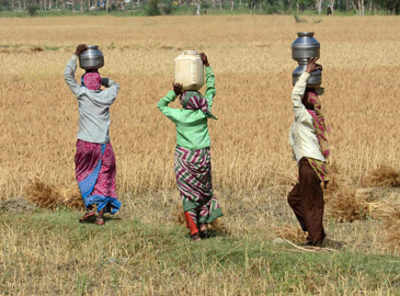- News
- India News
- By 2050, you may have to live on imported water
Trending
This story is from April 22, 2016
By 2050, you may have to live on imported water
Data shows that today the daily per capita groundwater availability in the country has come down to 5,120 litres, about 35% of the 14,180 litres in 1951. In 1991, it was less than half of the 1951 stock. And by 2025, it is projected that the daily per capita availability will be just 25% of the base year.

Village women climb down the ladder into pit to fetch water in the drought-hit Mhaismal village on the outskirts of Nashik. (TOI photo by Aditya Waikul)
MUMBAI: Do not be surprised if the country is forced to import drinking water by 2050, thanks to the fast-depleting groundwater stock that is expected to reduce to 3,120 litres per day a person by then.
Data shows that today — going by 2001 figures — the daily per capita groundwater availability in the country has come down to 5,120 litres, about 35% of the 14,180 litres in 1951.In 1991, it was less than half of the 1951 stock. And by 2025, it is projected that the daily per capita availability will be just 25% of the base year.
And the figures from a Central Ground Water Board (CGWB) study warn of a reduction to 22% by 2050, going by the present rate of exploitation of groundwater.
The depleting water beneath your feet is an indication of vanishing rainwater harvesting with ponds, lakes and wells, poor awareness, and reduced green cover, say experts.
Going by the fast-growing population and their increasing demands, the day may not be far when per person availability dips to the actual use.
Read this story in Hindi
Data shows that today — going by 2001 figures — the daily per capita groundwater availability in the country has come down to 5,120 litres, about 35% of the 14,180 litres in 1951.In 1991, it was less than half of the 1951 stock. And by 2025, it is projected that the daily per capita availability will be just 25% of the base year.
And the figures from a Central Ground Water Board (CGWB) study warn of a reduction to 22% by 2050, going by the present rate of exploitation of groundwater.
The depleting water beneath your feet is an indication of vanishing rainwater harvesting with ponds, lakes and wells, poor awareness, and reduced green cover, say experts.
A CGWB master plan to artificially recharge groundwater said: "Rapid development and use of groundwater resources for varied purposes has contributed, though, in expansion of irrigated agriculture, overall economic development and in improving the quality of life in urban India, the groundwater, which is the source for more than 85 per cent of rural domestic water requirements, 50 per cent of urban water requirements and over 50 per cent of irrigation requirements of the country, is depleting fast ."
Going by the fast-growing population and their increasing demands, the day may not be far when per person availability dips to the actual use.
Read this story in Hindi
End of Article
FOLLOW US ON SOCIAL MEDIA











